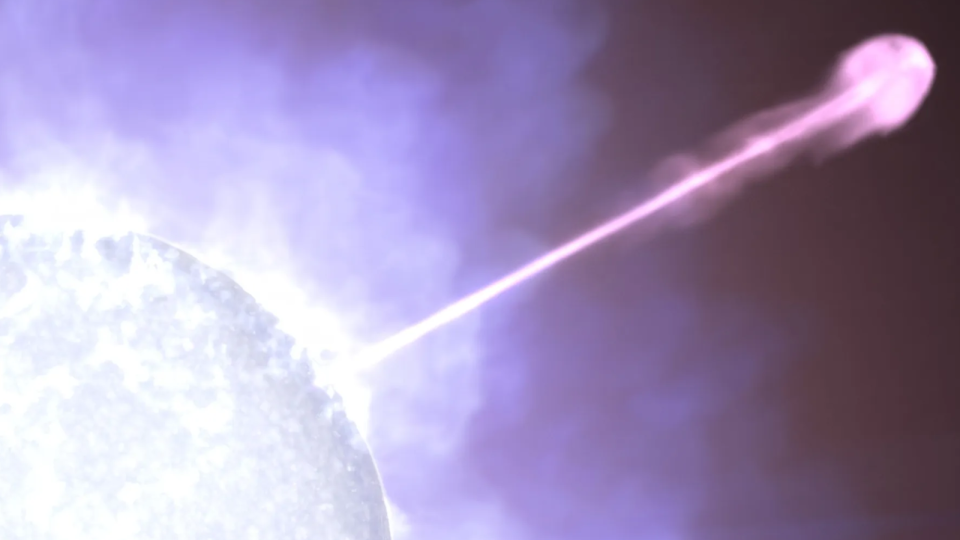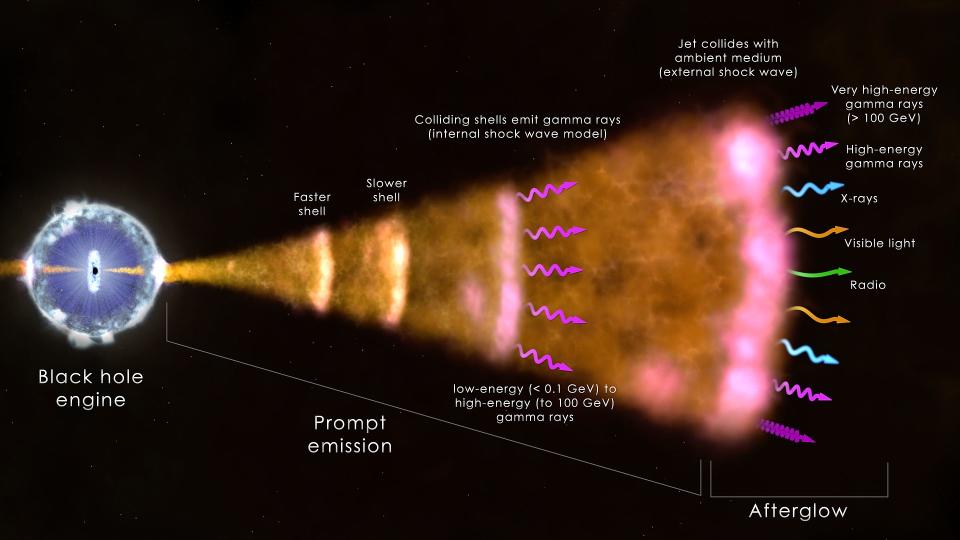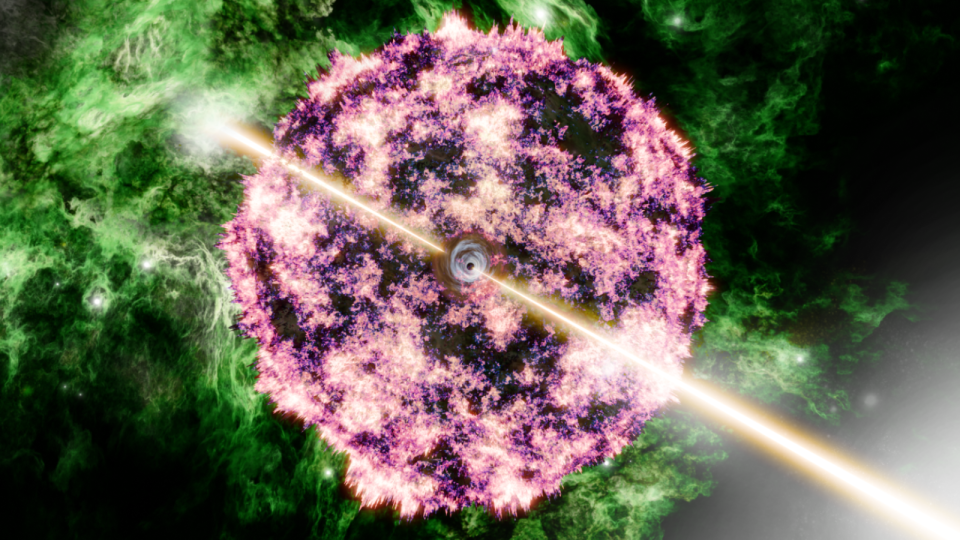When you buy through links in our articles, Future and its syndication partners may earn a commission.

NASA’s Fermi gamma-ray space telescope has probed what may have been the most powerful explosion since the Big Bang, discovering a previously unseen feature. The feature could be the result of matter and antimatter particles annihilating at 99.9% of the speed of light.
The explosion was an example of a gamma-ray burst (GRB); when it was first spotted on October 9, 2022, by NASA’s Fermi Gamma-ray Space Telescope and the Neil Gehrels Swift Observatory, it was designated GRB 221009A. The GRB’s power was soon revealed, and it was nicknamed the brightest of all time, or the “BOAT.”
“As long as we’ve been able to detect gamma-ray bursts, it’s clear that this gamma-ray burst is the brightest we’ve ever seen, by a factor of 10 or more,” explained Wen-fai Fong, an associate professor of physics and astronomy and leader of the Fong Group at Northwestern University and one of the discoverers of BOAT, around the time the star was thought to be so incredibly bright.
Scientists believe that the BOAT was launched by a supernova explosion that accompanied the death and collapse of a massive star located about 2.4 million light-years away. This event probably left behind a black hole.
Related: Scientists Identify Origin of ‘BOAT’ – Brightest Cosmic Explosion Ever
“A few minutes after BOAT erupted, Fermi’s Gamma-ray Burst Monitor detected an unusual energy spike that caught our attention,” said lead researcher Maria Edvige Ravasio of Radboud University in a statement. “When I first saw that signal, I got goosebumps. Our analysis since then shows that it is the first high-confidence emission line ever seen in 50 years of studying GRBs.”
What did Fermi find in the BOAT?
The first gamma-ray burst was observed in 1967 by the American Vela satellites. Two years later the event was officially recorded and shown to the public in 1973.
Since then, scientists have discovered a plethora of GRBs, establishing that these brief flashes of light have a cosmic origin and are the most powerful and violent explosions in the known universe. The most common type of GRB occurs when stars with at least eight times the mass of the sun run out of fuel for nuclear fusion in their cores and are no longer able to counteract the inward pull of their own gravity; their cores collapse in on themselves. This creates a spinning black hole that channels matter toward its poles and shoots it out in jets near the speed of light.
When these rays are aimed directly at Earth, we see them as a GRB.
GRBs are so powerful that if one erupted within a few thousand light years of Earth, it could wipe out life on our planet by disrupting or destroying the atmosphere. But even among all these terrifying events, BOAT stood out almost immediately.
Scientists eventually determined, using statistics from other observed GRBs, that an event as powerful and bright as BOAT would only be visible in the Earth’s sky once every 10,000 years. They also discovered that despite being 2.4 billion light-years away, BOAT was actually making an impact on Earth’s atmosphere.


On October 9, 2022, high-energy gamma-ray light from BOAT saturated most of the gamma-ray detectors on orbit, including the one aboard Fermi. This prevented the true power of the explosion from being measured at its most intense point in its duration. However, about five minutes after BOAT was detected, it faded enough for Fermi to see it again. NASA’s gamma-ray telescope spotted a curious feature in its light, or “spectra,” called a “putative emission line.”
When light passes through matter, elements, because they absorb and emit light at specific frequencies, leave absorption and emission “fingerprints” on this light. This means that scientists can reconstruct the elements that this light passed through and determine the chemical composition of objects with which it interacted.
“While some previous studies have reported possible evidence for absorption and emission features in other GRBs, closer examination revealed that these could all just be statistical fluctuations. What we see in BOAT is different,” team member Om Sharan Salafia of the INAF-Brera Observatory in Milan said in the statement. “We found that the probability that this feature is just a noise fluctuation is less than one in half a billion.”


The emission line Fermi saw in the light from BOAT lasted about 40 seconds and reached a peak energy of 12 million electron volts (MeV). The energy of light in the visible part of the electromagnetic spectrum is between two and three electron volts (eV).
The researchers think they know what caused this feature. Every particle of matter has an antimatter particle “twin.” When these particles meet, they annihilate and release their energy back into the universe. It’s possible that the spectral feature the team saw in BOAT comes from electrons and their antimatter counterparts, positrons, annihilating.
“When an electron and a positron collide, they annihilate, producing a pair of gamma rays with an energy of 0.511 MeV,” team member Gor Oganesyan of the Gran Sasso Science Institute said in the statement. “Because we are looking into the beam, where matter is moving at nearly the speed of light, this emission is enormously blueshifted and pushed to much higher energies.”
If the team is correct, the particles must have been traveling at about 99.9% of the speed of light before destroying each other.
Related Stories:
—The brightest gamma-ray burst ever observed, the largest known explosion since the Big Bang, has a unique jet structure unlike any other
— Pulsar surprises astronomers with record-breaking gamma-ray burst
— The elusive origin of long gamma-ray bursts may finally be revealed
“After decades of studying these incredible cosmic explosions, we still don’t understand the details of how these jets work,” team member Elizabeth Hays, the Fermi project scientist at NASA’s Goddard Space Flight Center, said in the statement. “Finding clues like this is remarkable.”
The team’s research was published Friday (July 26) in the journal Science.